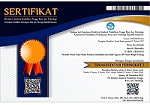Al-Qur’an dan Pengobatan Tradisional: Studi Living Qur’an Pada Masyarakat Probolinggo Jawa Timur
Abstract
Keywords
Full Text:
PDFReferences
Ainiyah, Luthfiatul. “Penggunaan Ayat-Ayat Al-Qur’an Sebagai Pengobatan (Studi Living Qur’an Praktik Ruqyah Oleh Jam’iyyah Ruqyah Aswaja Tulungagung).” IAIN Tulungagung, 2019.
Al-Bukhārī, Muḥammad ibn Ismā‘īl. Sahih Bukhari. Lebanon: Dar al-Fikr, 2006.
Ardianto, Muhammad. “The Concept Of Jin And Ruqyah According To The Komunitas Keluarga Besar Ruqyah Aswaja: The Study Of Living Qur’an.” Mushaf: Jurnal Tafsir Berwawasan Keindonesiaan 2, no. 1 (2021): 163–87. https://doi.org/10.33650/mushaf.v2i1.3344.
Basid, Abd. “Peningkatan Tarif Hidup Layak Melalui Produktivitas Bekerja Perspektif Al-Qur’an.” Jurnal Studi Ilmu-Ilmu Al-Qur’an Dan Hadis 12, no. 21 (2020): 174–92. https://doi.org/10.14421/qh.2020.2101-09.
Chalida, Sri. “Tradisi Pembacaan Surat Al-Waqi’ah Dan Surat Al-Mulk Di Pondok Pesantren Mambaul Hikam Ii Karanggayam Blitar Jawa Timur.” Jurnal Ulunnuha 7, no. 1 (2018): 105–15. https://doi.org/10.15548/ju.v7i1.242.
Cheteh, Masuphi. “Penggunaan Ayat Al-Qur’an Sebagai Media Pengobatan (Studi Living Qur’an Pada Praktik Pengobatan Ustadz Ismail Di Kampung Meanea Provinsi Narathiwat Thailand).” Institut Agama Islam Negeri Jember, 2020.
Esack, Farid. The Qur’an: A Short Introduction. London: Oneworld Publication, 2002.
Faizah, Thoriqotul. “Interacting With The Qur’an In Pandemic Times: The Study Of Living The Qur’an At Pondok Pesantren.” Mushaf: Jurnal Tafsir Berwawasan Keindonesiaan 2, no. 1 (2021): 74–102. https://doi.org/10.33650/mushaf.v2i1.3335.
Fawaid, Ahmad. “Filologi Naskah Tafsîr Bi Al-Imlâ’ Surat Al-Baqarah Karya Kyai Zaini Mun’Im.” Jurnal Studi Ilmu-Ilmu Al-Qur’an Dan Hadis 20, no. 2 (2019): 143–62. https://doi.org/10.14421/qh.2019.2002-02.
Husna, Rifqatul, Alnafa Dita Setiarni, and Anna Wasilatul Bariroh. “Program Majelisan Dalam Meningkatkan Kualitas Hafalan (Studi Living Qur’an Di Pusat Pendidikan Ilmu Al-Qur’an Pondok Pesantren Nurul Jadid Paiton Probolinggo).” Hamalatul Qur’an: Jurnal Ilmu-Ilmu Al-Qur’an 2, no. 2 (2021): 37–45. https://doi.org/10.37985/hq.v2i2.19.
Mansyur, M., Muhammad Chirzin, Muhammad Yusuf, Abdul Mustaqim, Suryadi, M. Alfatih Suryadilaga, and Nurun Najwah. Metodologi Penelitian Living Qur’an Dan Hadis. I. Yogyakarta: Teras, 2007.
Musolli, Ach. Zayyad, and Ika Maziyah. “Living Qurán Tradisi Islam Nusantara: Kajian Terhadap Pelet Betteng Pada Masyarakat Probolinggo.” Jurnal Islam Nusantara 05, no. 01 (2021): 37–51. https://doi.org/10.33852/jurnalin.v5i2.287.
Najiburrohman, and Fitriyatul Hasanah. “Student Reception On The Implementation Of One Day One Page: Study Living Qur’an At Pondok Pesantren.” Murhaf: Jurnal Tafsir Berwawasan Keindonesiaan 2, no. 2 (2022): 43–59. https://doi.org/10.33650/mushaf.v2i2.3351.
Rajab, Z, H Rajab, and N Rustina. “Telaah Kritis Kehadisan Teks ‘Menuntut Ilmu Di Waktu Kecil Laksana Mengukir Di Atas Batu.’” Jurnal Ulunnuha 9, no. 2 (2020): 136–54.
Romziana, Luthviyah, Fatimah, Amelia Putri, and Linda Fajarwati. “Santri Reception Against Samadiyah Recitation To Free The Corpse From The Torment Of The Grave.” Mushaf: Jurnal Tafsir Berwawasan Keindonesiaan 2, no. 2 (2022): 1–19. https://doi.org/http://doi.org/10.33650/mushaf.v2i2.3306.
Shihab, M. Quraish. Wawasan Al-Qur’an: Tafsir Mawdhu’i Atas Berbagai Persoalan Umat. Bandung: Mizan, 2000.
Zahrofani, Destira Anggi, and Moh Alwy Amru Ghozali. “Kajian Living Qur’an: Tradisi Pembacaan Surah Al-Kahfi Di Pondok Pesantren Putri Al-Ibanah.” In Proceeding of The 2ndConference on Strengthening Islamic Studies in the Digital Era, 74–89. Ponorogo: Fakultas Ushuluddin, Adab, dan Dakwah, 2022.
Refbacks
- There are currently no refbacks.

This work is licensed under a Creative Commons Attribution-NonCommercial-ShareAlike 4.0 International License.
Prodi Ilmu Al-Qur`an dan Tafsir, Fakultas Ushuluddin Dan Studi Agama, UIN Imam Bonjol Padang
Jl. Sungai Bangek, Kel. Balai Gadang, Kec. Koto Tangah.
Kota Padang, Sumatera Barat, 25171
E-mail: jurnal-ulunnuha@uinib.ac.id

This work is licensed under a Creative Commons Attribution-ShareAlike 4.0 International License.





1.jpg)
.jpg)